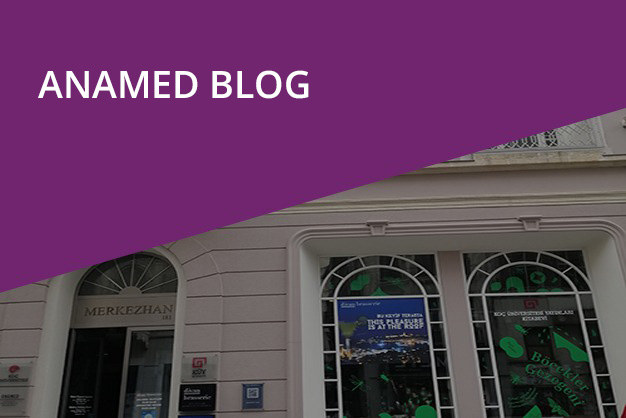
This blog post is intended as a guide to Ottoman research in Beyoğlu. It aims to quick start research and point to easily accessible resources in and around ANAMED. Beyoğlu is filled with libraries, and this list is not exhaustive.
1) ANAMED Library
The ANAMED library is very well run. The director of the library organizes talks that are pleasant to attend. The most useful aspect of this library is its location: the library is within 1 minute of your room and open 24/7 to fellows. After the library closes, or before it opens, it is particularly pleasant to work there. The collection it has is big and specialized in Anatolian studies (Byzantium, as well as the Seljuk and Ottoman empires); other works can be requested through the Koç intercampus system or the inter-university system.
For Ottoman historians going to the Başbakanlık archives, the library provides computers with CD readers, so it is possible to copy documents to a flash drive. The library also has a scanner that works well.
2) Institue français d’études anatoliennes
L’Institut français d’études anatoliennes is located within 2 minutes of ANAMED. Walking down the hill, you arrive at the Fransız Saray. Entry requires an appointment, which takes less than 24 hours to book if you email between Monday and Thursday. The place has many specialized books, a nice collection of dictionaries, and a vast variety of works and doctoral theses in French. The biggest hurdle with this place is simply the need to make appointments.
3) Istanbul Research Institute
The Istanbul Research Institute library is a charming place within 2 minutes of ANAMED. The library is open during weekdays. The place is spacious, and its book selection is ideal for Ottoman and art history researchers. As a side note, let me just highlight that the collection includes some beautiful editions of works about İstanbul, ideal to improve your general understanding of the city and its history! The staff is extremely kind, and the place is spacious and filled with light. Ideal for unexpected winter hazards.
4) Süleymaniye library
This is by far the most pleasant place to work in! Leaving ANAMED to go there takes less than 30 minutes. Walkers can reach the place in less than an hour, with pleasant stops possible around Fatih, the Galata bridge, or in Karaköy. Once you get there, the staff is pleasant and helpful. The location is also ideal, as you can easily eat in the Süleymaniye complex or in a nearby restaurant or esnaf lokantası. The library includes a vast variety of library catalogues. Spending time with these catalogs is useful. They are sometimes more useful in finding manuscripts than the new online catalog. When using the computer, make sure to use the old catalog as well, as some descriptions (and manuscripts, I am told) have vanished from the new database.
5) Ottoman archives:
The Cumhurbaşkanlığı Devlet Arşivleri (commonly referred to by its previous title Başbakanlık Osmanlı Arşivi, often cited as BOA in scholarly work) is located in Kağıthane. Its location is not ideal—far from it. It comes with the disadvantages of palace-like buildings: its size makes it an extremely long trip to go for lunch, to the restroom, or to the locker room. Plan your days ahead with a lunch, and be ready to spend 30 minutes waiting for the bus on your way back. The staff usually provides CDs with copies of documents, which can now be paid for by card only. The place has a nice and convenient cafe to chat with other highly motivated historians.
6) The Forgotten Kubbe Altı:
Ottoman historians who have only known the Kağıthane location of the Ottoman archives usually think of Kubbealtı as a useful online dictionary. But back when the archive was still located in Fatih, Kubbealtı also evoked the photocopy shop that was located right by the archives. The small shop still stands and copies useful books. But photocopy is a very modest word to describe the work done by the shop owners. They print and re-edit old works, including in the Ottoman script, with a hard cover. The price is relatively affordable, but the quality of the print and binding is unmatched. The selection of prints they have is significant, and their selection includes rare materials and dictionaries.

